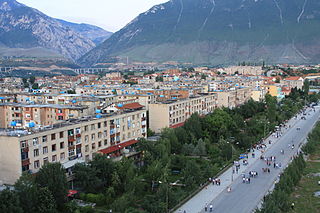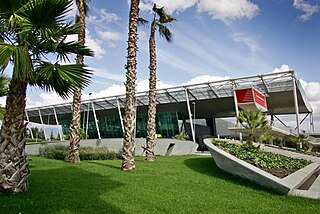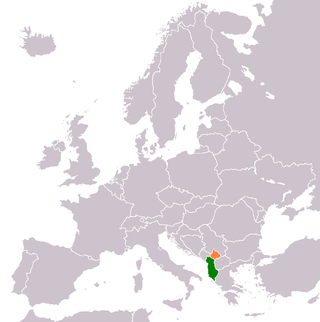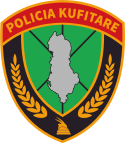
Transport in Albania consists of transport by land, water and air, which are predominantly under the supervision of the Ministry of Infrastructure of Albania. The development and improvement of the transport in the country remains among the most important priorities of the Government of Albania.

The economy of Albania went through a process of transition from a centralized economy to a market-based economy on the principles of the free market.

Kukës is a city in the Republic of Albania. The city is the capital of the surrounding municipality of Kukës and county of Kukës, one of 12 constituent counties of the republic. It spans 8.2 square kilometres (3.2 sq mi) and had a total population of 16,719 people as of 2011.

Tirana International Airport Nënë Tereza, often referred to as the Rinas International Airport, is one of the two main international airports of the Republic of Albania. It serves the city of Tirana, its metropolitan area, and surrounding region in the county of Tirana. The airport is named in honour of the Albanian Roman Catholic nun and missionary, Mother Teresa (1910–1997). It is located 6 nautical miles northwest of Tirana, in the municipality of Krujë, Durrës County.

Tirana County, officially the County of Tirana, is a county in the Central Region of the Republic of Albania. It is the tenth largest by area and the most populous of the twelve counties, with more than 912,000 people within an area of 1,652 km2 (638 sq mi). The county borders on the Adriatic Sea to the west, the counties of Durrës to the northwest, Dibër to the northeast, Elbasan to the east and Fier to the southwest. It is divided into five municipalities, Tirana, Kamëz, Kavajë, Rrogozhinë and Vorë, with all of whom incorporate twenty-nine administrative units.

The European Border and Coast Guard Agency, commonly known as Frontex, is an agency of the European Union headquartered in Warsaw, Poland. In coordination with the border and coast guards of member states, it exercises border control of the European Schengen Area, a task within the area of freedom, security and justice domain. Formally, the Agency's remit is to "support Member States on the ground in their efforts to protect the external borders"; it does not have authority to act otherwise unless "external border control" [by a member state] "is rendered ineffective to such an extent that it risks jeopardising the functioning of the Schengen area".

In 1997, widespread civil unrest struck Albania due to economic problems in the country, that were caused by the collapse of pyramid schemes. Due to the large quantities of money robbed from the government to fund the schemes, the Democratic Party's government collapsed in January 1997. More than 2,000 people were killed in the conflict until its end in August 1997. The creation of a new government came as the revolutionaries surrounded Tirana. Various other sources also describe the violence that ensued as a rebellion or even a civil war.
In 1991, the Socialist Party of Albania, with specific social democratic ideology took control of the country through democratic elections. One year later the Democratic Party of Albania won the new elections. After 1990, Albania has been seeking a closer relationship with the West. What followed were deliberate programs of economic and democratic reform, but the implementation of capitalism led to the proliferation of pyramid schemes. Chaos in late 1996 to early 1997, as a result of the collapse of these pyramid schemes, alarmed the world and prompted the influx of international peacekeeping forces. In 1995, Albania was accepted into the Council of Europe and requested membership in NATO and is a potential candidate country for accession to the European Union. The workforce of Albania has continued to emigrate to Western countries, especially Greece and Italy.

Albania–Kosovo relations refer to the current, cultural and historical relations of Albania and Kosovo. Albania has an embassy in Pristina and Kosovo has an embassy in Tirana. There are 1.8 million Albanians living in Kosovo – officially 92.93% of Kosovo's entire population – and Albanian is an official language and the national language of Kosovo. Likewise, the peoples of the two countries have practically identical traditions and folklore. Kosovo is the birthplace of Albanian nationalism such as the League of Prizren. In addition, the strong relations are highlighted in successive polls showing majority of ethnic Albanians in both states wanting unification. Both countries and their citizens refer to the relationship as "one nation, two states" as highlighted in the popular pan-Albanian slogan "Jemi një".

The A1, also commonly Rruga e Kombit or SH10, is the longest and only toll motorway in Albania, stretching 114 kilometres (71 mi) in the counties of Lezhë and Kukës. It consists for the most part of two traffic lanes and an emergency lane in each driving direction separated by a central reservation.
Border crossings in the Republic of Albania are defined as boundary checkpoints that serve to control the flow of people and goods from neighbouring countries to and from Albania. These checkpoints are administered by the border police authorities that record the entry and exit of each person and vehicle followed by the customs authorities that record the entry and exit of goods and cash. Albania currently has 22 operational land border crossings and shares borders with Montenegro, Kosovo, North Macedonia, and Greece. This article outlines a complete list of Albania's international border crossings, including land, sea and air entry points.

The Durrës–Tiranë railway was a railway line which initially joined the two biggest cities in Albania, Durrës and Tirana. The line connected to the Shkodër–Vorë railway halfway in Vorë, and connected onwards to the Durrës-Vlorë railway and Durrës-Pogradec railway in Durrës.

Kukës International Airport Zayed-North Wings, also referred to as Kukës International Airport Zayed, is an international airport in Kukës, Kukës County, Albania. The airport is located 3.5 km (2.2 mi) south of the city of Kukës. The main purpose of Kukës International Airport is to serve as an alternative airport to Tirana International Airport Nënë Tereza.

The national road SH1 is a national highway in Albania. It has a length of 125 kilometres (78 mi) across the counties of Durrës, Lezhë, Shkodër and Tirana.

The border of the European Union consists of the land borders that member states of the EU share with non-EU states adjacent to the union.

The Highways in Albania are the central state and main transport network in Albania. The motorways and expressways are both part of the national road network. The motorways are primary roads with a speed limit of 110 kilometres per hour (68 mph). They have white on green road signs such as in Italy and other countries nearby. The expressways are the secondary roads, also dual carriageways, but without an emergency lane. They have a speed limit of 90 kilometres per hour (56 mph). They have white on blue road signs.

The Vlora was a cargo ship built in 1960 in Ancona (Italy) that sailed under the Albanian flag until 1996. It is most famous for carrying tens of thousands of Albanian refugees to the Italian port of Bari on 8 August 1991, an unprecedented mass arrival that caught Italian authorities unaware.

Squatting in Albania began on a large scale in the 1990s after the fall of communism, with internal migration towards formerly collectivised farmland establishing informal settlements. One such area, Bathore on the periphery of the capital Tirana, had 40,000 squatters by the early 2000s who successfully campaigned for better amenities. Other squatters occupied severely polluted post-industrial sites. The Agency of Legalization, Upgrading, and Integration of Informal Zones and Buildings (ALUIZNI) had legalized 16,500 homes on 152 settlements by 2009. As of 2020, 25 per cent of the population of Albania's cities lived in informal settlements.
Operation HERA is a joint maritime operation by the European Union established to manage migration flows and stop irregular migrants along the Western African Route, from the western shores of Africa to the Canary Islands, Spain. The operation was implemented following an increase in migrants arriving at the Canary Islands in 2006. It remains an annual operation managed by Spain and the European Border and Coast Guard Agency (FRONTEX).

















